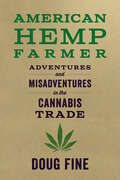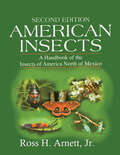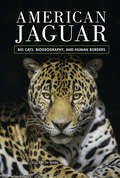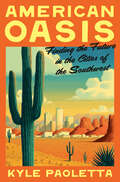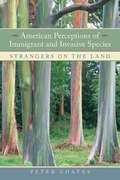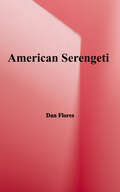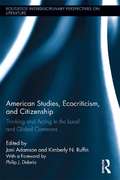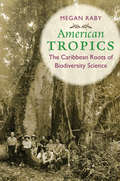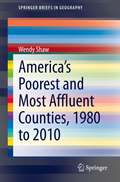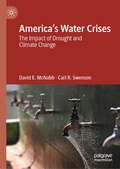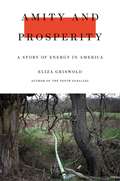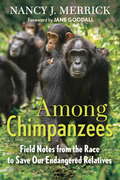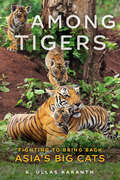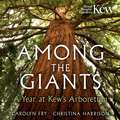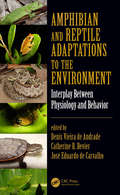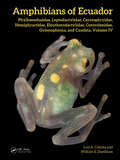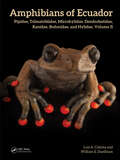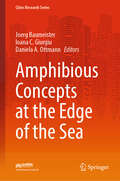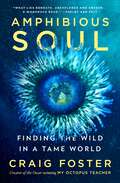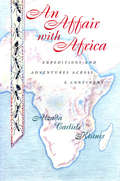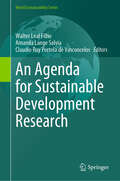- Table View
- List View
American Hazardscapes: The Regionalization of Hazards and Disasters
by Natural Hazardas DisasterBarrier islands. Flood plains. Earthquake faults. Sometimes the environment poses threats to our well being, yet many of us continue to choose to live in risky or dangerous places. And on top of the “knowns” are the other, more hidden hazards related to environmental contamination that pose equally serious threats to our health and well being.But where are these places and what types of hazards are found there? American Hazardscapes examines the risks associated with living and owning property in diverse regions across the United States, offering dual perspectives: that of the geographer and that of the social science hazards researcher. The book summarizes what we already know about regional patterns of hazard events and losses during the previous three decades and goes further to shed light on the nature of the events themselves and their impact on society.Written for the relocating citizen and the policy maker alike, American Hazardscapes presents a regional ecology of disaster-prone or disaster-resistant states. It also offers thoughts on what local, state, and federal managers need to do to meet the challenge of reducing hazard losses in the next century.
American Hemp Farmer: Adventures and Misadventures in the Cannabis Trade
by Doug FineThe inside story of the world&’s most fascinating and lucrative crop from gonzo journalist–turned–hemp farmer Doug Fine.Hemp, the non-psychoactive variant of cannabis (or marijuana) and one of humanity&’s oldest plant allies, has quietly become the fastest industry ever to generate a billion dollars of annual revenue in North America. From hemp seed to hemp fiber to the currently ubiquitous cannabinoid CBD, this resilient crop is leading the way toward a new, regenerative economy that contributes to soil and climate restoration—but only if we do it right.In American Hemp Farmer, maverick journalist and solar-powered goat herder Doug Fine gets his hands dirty with healthy soil and sticky with terpenes growing his own crop and creating his own hemp products. Fine shares his adventures and misadventures as an independent, regenerative farmer and entrepreneur, all while laying out a vision for how hemp can help right the wrongs of twentieth-century agriculture, and how you can be a part of it.
American Imperial Pastoral: The Architecture of US Colonialism in the Philippines
by Rebecca Tinio MckennaIn 1904, renowned architect Daniel Burnham, the Progressive Era urban planner who famously “Made No Little Plans,” set off for the Philippines, the new US colonial acquisition. Charged with designing environments for the occupation government, Burnham set out to convey the ambitions and the dominance of the regime, drawing on neo-classical formalism for the Pacific colony. The spaces he created, most notably in the summer capital of Baguio, gave physical form to American rule and its contradictions. In American Imperial Pastoral, Rebecca Tinio McKenna examines the design, construction, and use of Baguio, making visible the physical shape, labor, and sustaining practices of the US’s new empire—especially the dispossessions that underwrote market expansion. In the process, she demonstrates how colonialists conducted market-making through state-building and vice-versa. Where much has been made of the racial dynamics of US colonialism in the region, McKenna emphasizes capitalist practices and design ideals—giving us a fresh and nuanced understanding of the American occupation of the Philippines.
American Insects: A Handbook of the Insects of America North of Mexico, Second Edition
by Ross H. Arnett Jr.Offering a complete accounting of the insects of North America, this handbook is an up-dated edition of the first handbook ever compiled in the history of American entomology.By using American Insects, A Handbook of the Insects of America North of Mexico, Second Edition, readers can quickly determine the taxonomic position of any species, genus, or
American Jaguar: Big Cats, Biogeography, and Human Borders
by Elizabeth WebbIn the borderlands between the United States and Mexico, America's largest cat—the jaguar—is fighting to regain its kingdom. Added to the endangered species list in 1997, the jaguar has declined in population mainly due to habitat fragmentation created by roads, farms, mines, and most controversially, the border wall. Such human-made barriers prevent free movement of many wild animals for predation and mating, thereby threatening their reproduction, DNA transfer, and overall survival. Author and wildlife biologist Elizabeth Webb examines the jaguar's predicament and highlights the work of field scientists who are searching for solutions. "Conservation Connection" features throughout the book underscore the importance of protecting this keystone species of the Americas.
American Oasis: Finding the Future in the Cities of the Southwest
by Kyle PaolettaAn expansive and revelatory historical exploration of the multicultural, water-seeking, land-destroying settlers of the most arid corner of North America, arguing that in order to know where the United States is going in the era of mass migration and climate crisis we must understand where the Southwest has already beenAlbuquerque. Phoenix. Tucson. El Paso. Las Vegas. Iconic American cities surrounded by desert and rust. Teeming metropolises that seem to exist independently of the seemingly inhospitable and arid landscape that surrounds them, belying the rich insight they offer into American stories of migration, industry, bloodshed, and rebirth. Charting a geographic path through America's largest and hottest deserts, acclaimed journalist Kyle Paoletta maps the past and future of these cities, and the many other settlements from rural town to urban sprawl that make up the region that has come to be called &“the American Southwest.&” Weaving together the stories of immigrants and indigenous populations, American Oasis pulls back the layers of settlement, sediment, habit, and effect that successive empires have left on the region, from the Athapascan, Diné, Tewa, Apache, and Comanche, to the Spanish, Mexican, and, finally, American. As Paoletta&’s journey into the Southwest&’s history becomes inextricably linked to an exploration of its dependency on water, he begins to ask: where, ultimately, will cities like Las Vegas and Phoenix find themselves once the Colorado River and its branches dry up? Richly reported and sweeping in its history, American Oasis is the story of what one iconic region&’s past can tell us about our shared environmental and cultural future.
American Perception of Immigrant and Invasive Species: Strangers on the Land
by Peter CoatesSetting the saga of human relations with the environment in the broad context of scientific, social, and cultural history, this thought-provoking book demonstrates how profoundly notions of nationality and debates over race and immigration have shaped American understandings of the natural world.
American Serengeti: The Last Big Animals of the Great Plains
by Dan FloresAmerica's Great Plains once possessed one of the grandest wildlife spectacles of the world, equaled only by such places as the Serengeti, the Masai Mara, or the veld of South Africa. Pronghorn antelope, gray wolves, bison, coyotes, wild horses, and grizzly bears: less than two hundred years ago these creatures existed in such abundance that John James Audubon was moved to write, "it is impossible to describe or even conceive the vast multitudes of these animals." In a work that is at once a lyrical evocation of that lost splendor and a detailed natural history of these charismatic species of the historic Great Plains, veteran naturalist and outdoorsman Dan Flores draws a vivid portrait of each of these animals in their glory--and tells the harrowing story of what happened to them at the hands of market hunters and ranchers and ultimately a federal killing program in the nineteenth and twentieth centuries. The Great Plains with its wildlife intact dazzled Americans and Europeans alike, prompting numerous literary tributes. American Serengeti takes its place alongside these celebratory works, showing us the grazers and predators of the plains against the vast opalescent distances, the blue mountains shimmering on the horizon, the great rippling tracts of yellowed grasslands. Far from the empty "flyover country" of recent times, this landscape is alive with a complex ecology at least 20,000 years old--a continental patrimony whose wonders may not be entirely lost, as recent efforts hold out hope of partial restoration of these historic species. Written by an author who has done breakthrough work on the histories of several of these animals--including bison, wild horses, and coyotes--American Serengeti is as rigorous in its research as it is intimate in its sense of wonder--the most deeply informed, closely observed view we have of the Great Plains' wild heritage.
American Studies, Ecocriticism, and Citizenship: Thinking and Acting in the Local and Global Commons (Routledge Interdisciplinary Perspectives on Literature)
by Philip J. Deloria Joni Adamson Kimberly N. RuffinThis collection reclaims public intellectuals and scholars important to the foundational work in American Studies that contributed to emerging conceptions of an "ecological citizenship" advocating something other than nationalism or an "exclusionary ethics of place." Co-editors Adamson and Ruffin recover underrecognized field genealogies in American Studies (i.e. the work of early scholars whose scope was transnational and whose activism focused on race, class and gender) and ecocriticism (i.e. the work of movement leaders, activists and scholars concerned with environmental justice whose work predates the 1990s advent of the field). They stress the necessity of a confluence of intellectual traditions, or "interdisciplinarities," in meeting the challenges presented by the "anthropocene," a new era in which human beings have the power to radically endanger the planet or support new approaches to transnational, national and ecological citizenship. Contributors to the collection examine literary, historical, and cultural examples from the 19th century to the 21st. They explore notions of the common—namely, common humanity, common wealth, and common ground—and the relation of these notions to often conflicting definitions of who (or what) can have access to "citizenship" and "rights." The book engages in scholarly ecological analysis via the lens of various human groups—ethnic, racial, gendered, coalitional—that are shaping twenty-first century environmental experience and vision. Read together, the essays included in American Studies, Ecocriticism, and Citizenship create a "methodological commons" where environmental justice case studies and interviews with activists and artists living in places as diverse as the U.S., Canada, Haiti, Puerto Rico, Taiwan and the Navajo Nation, can be considered alongside literary and social science analysis that contributes significantly to current debates catalyzed by nuclear meltdowns, oil spills, hurricanes, and climate change, but also by hopes for a common future that will ensure the rights of all beings--human and nonhuman-- to exist, maintain, and regenerate life cycles and evolutionary processes
American Tropics: The Caribbean Roots of Biodiversity Science (Flows, Migrations, and Exchanges)
by Megan RabyBiodiversity has been a key concept in international conservation since the 1980s, yet historians have paid little attention to its origins. Uncovering its roots in tropical fieldwork and the southward expansion of U.S. empire at the turn of the twentieth century, Megan Raby details how ecologists took advantage of growing U.S. landholdings in the circum-Caribbean by establishing permanent field stations for long-term, basic tropical research. From these outposts of U.S. science, a growing community of American "tropical biologists" developed both the key scientific concepts and the values embedded in the modern discourse of biodiversity.Considering U.S. biological fieldwork from the era of the Spanish-American War through the anticolonial movements of the 1960s and 1970s, this study combines the history of science, environmental history, and the history of U.S.–Caribbean and Latin American relations. In doing so, Raby sheds new light on the origins of contemporary scientific and environmentalist thought and brings to the forefront a surprisingly neglected history of twentieth-century U.S. science and empire.
America’s Poorest and Most Affluent Counties, 1980 to 2010 (SpringerBriefs in Geography)
by Wendy ShawThis book explores the changing spatial distribution of the United States of America's poorest and most affluent counties over the 30 years from 1980 to 2010. While overall rates of poverty have changed somewhat during this period, the geography of counties where affluence and poverty rates are the highest have also shifted as economic fortunes wax and wane. The spatial understanding of poverty and affluence is an important dimension of addressing the complex economic and social contexts within which poverty occurs, and which vary substantially depending on several factors. While there has been significant focus on poverty in the United States, including some analysis of its spatial characteristics, since the 1960s there has been relatively little research on the concomitant geography of affluence. The geographies of poverty and affluence analyzed in this book give a view of spatial economic segregation. Spatial aspects of both the poorest and most affluent counties are focused on, as well as the changing gap and relative geographies between rich and poor over three decades.
America’s Water Crises: The Impact of Drought and Climate Change
by David E. McNabb Carl R. SwensonThis book is focused exclusively on water problems in the 48 U.S. states. The authors provide an accessible overview of the work of many federal, state and academic researchers and water system administrators whose investigations have focused on the state of water and the water crisis now accelerating in the United States. David McNabb and Carl Swenson seek to bring to a wider audience some of the current research findings and data on the perilous state of the United States’ surface and groundwater resources during this time of climate change and the extreme drought taking place in many sections of the nation. Descriptions of the water resource systems are based on research and the subsequent findings published by water scientists in the United States Geological Survey, the Environmental Protection Agency, the U.S. Corps of Engineers and water related agencies of the Departments of Agriculture and of the Interior and state and local water management agencies.
Amity and Prosperity: One Family and the Fracturing of America
by Eliza Griswold<p>In Amity and Prosperity, the prizewinning poet and journalist Eliza Griswold tells the story of the energy boom’s impact on a small town at the edge of Appalachia and one woman’s transformation from a struggling single parent to an unlikely activist. <p>Stacey Haney is a local nurse working hard to raise two kids and keep up her small farm when the fracking boom comes to her hometown of Amity, Pennsylvania. Intrigued by reports of lucrative natural gas leases in her neighbors’ mailboxes, she strikes a deal with a Texas-based energy company. Soon trucks begin rumbling past her small farm, a fenced-off drill site rises on an adjacent hilltop, and domestic animals and pets start to die. When mysterious sicknesses begin to afflict her children, she appeals to the company for help. Its representatives insist that nothing is wrong. <p>Alarmed by her children’s illnesses, Haney joins with neighbors and a committed husband-and-wife legal team to investigate what’s really in the water and air. Against local opposition, Haney and her allies doggedly pursue their case in court and begin to expose the damage that’s being done to the land her family has lived on for centuries. Soon a community that has long been suspicious of outsiders faces wrenching new questions about who is responsible for their fate, and for redressing it: The faceless corporations that are poisoning the land? The environmentalists who fail to see their economic distress? A federal government that is mandated to protect but fails on the job? Drawing on seven years of immersive reporting, Griswold reveals what happens when an imperiled town faces a crisis of values, and a family wagers everything on an improbable quest for justice.</p>
Among Chimpanzees
by Jane Goodall Nancy J. MerrickA former student and colleague of Jane Goodall shares stories of chimps and their heroes, and takes readers on a journey to save man's closest relative. Unbeknownst to much of the public, chimps are in trouble: censuses show them to be extinct in four African countries and nearly so in ten others. A large percentage of the remaining populations live in unprotected, increasingly fragmented forests. When Nancy Merrick learned these startling facts in 2009, she decided it was past time to discover the extent to which chimpanzees are at risk across Africa and what can be done. Merrick had begun working with primates in 1972 as a young field assistant in Jane Goodall's famous Gombe camp. Like the rest of the world at the time, she was swept up in the excitement of discovering the remarkable world of chimpanzees--their ability to fashion tools, their dazzling intelligence, and their complex relationships and societies. From that moment on, her human-centered worldview shifted, and she became a devoted advocate for our closest genetic relatives. When Merrick returns to Africa decades later, she's alarmed by how much has changed. Human activity, such as agriculture and logging, has encroached on natural habitats throughout equatorial Africa, endangering chimpanzees, gorillas, and bonobos. In an effort to understand what we can do to save great apes, Merrick connects with primatologists and conservationists who are trying to protect the last great forests. Visits to some of Africa's parks, sanctuaries, and expanding agricultural areas reveal the urgency of the problems and the inspiration of the people leading the search for solutions. Along the way, Merrick demonstrates that the best hope for chimps and other great apes lies in connecting conservation to humanitarian efforts, ensuring a healthy future for animals and humans alike. Among Chimpanzees is at once an inspiring chronicle of Merrick's personal search to learn how chimps are faring across Africa and in captivity, a crucial eyewitness account of a very critical period in their existence, and a rousing call for us to join the efforts to be a voice for the chimpanzees, before it's too late.From the Hardcover edition.
Among Tigers: Fighting to Bring Back Asia's Big Cats
by K. Ullas KaranthToday ten times more tigers live in captivity than survive in the wild. For over five decades, K. Ullas Karanth has been engaged in the struggle to bring wild tigers back from the brink in India, their last remaining wild stronghold. He tells the story of the tiger itself—its incredible biology, its critical role in shaping natural ecosystems of Asia, and the unique place it holds in our collective imagination.Among Tigers is the story of how we wound up with fewer than 5,000 wild tigers, and how, with focused efforts we can grow that population ten times or more in a few decades. In doing so, we would bring not only the world's largest and most beloved feline back from the brink, but also save countless other species that share the tigers habitats from the freezing forests of Siberia to the tropics of India. Karanth shares the adventurous real-life story of his quest to save a species and, along the way, the hopeful realization that tiger conservation is a battle that can be won.Ultimately, the book is a roadmap showing us how to not only to save the greatest of great cats, but to bring it roaring back at numbers never before seen in our lifetimes.
Among the Giants: A Year at Kew's Arboretum
by Kew GardensStretching across two-thirds of the Gardens, the arboretum at Kew surrounds the glasshouses in a leafy enclave to walk, wander and discover nature's beauty. The 12,000 trees rooted in the arboretum represent more than 2,000 species, including rare and ancient varieties. This great collection contains trees as old as the Gardens themselves, many that cannot be found anywhere else in Britain.But who looks after these vast landscapes?Introducing the Tree Gang - Kew's team of eight who work tirelessly throughout the year to maintain this rare collection.In this new book from Kew, you'll discover the fascinating work of the Tree Gang: the team of eight that care for the trees at Kew. Going behind the scenes, you'll learn more about life at Kew from the people who tend and care for the Gardens - from the daily tree assessments to the intermittent tree felling. As the climate becomes more variable, the gang's work is ever more crucial as they brace for the storms ahead.AMONG THE GIANTS weaves together heartwarming stories alongside the fascinating life of trees. This book will inspire you to learn from the experts, and grow an appreciation for the trees around you.
Among the Giants: A Year at Kew's Arboretum
by Kew GardensStretching across two-thirds of the Gardens, the arboretum at Kew surrounds the glasshouses in a leafy enclave to walk, wander and discover nature's beauty. The 12,000 trees rooted in the arboretum represent more than 2,000 species, including rare and ancient varieties. This great collection contains trees as old as the Gardens themselves, many that cannot be found anywhere else in Britain.But who looks after these vast landscapes?Introducing the Tree Gang - Kew's team of eight who work tirelessly throughout the year to maintain this rare collection.In this new book from Kew, you'll discover the fascinating work of the Tree Gang: the team of eight that care for the trees at Kew. Going behind the scenes, you'll learn more about life at Kew from the people who tend and care for the Gardens - from the daily tree assessments to the intermittent tree felling. As the climate becomes more variable, the gang's work is ever more crucial as they brace for the storms ahead.AMONG THE GIANTS weaves together heartwarming stories alongside the fascinating life of trees. This book will inspire you to learn from the experts, and grow an appreciation for the trees around you.
Among the Giants: A Year at Kew's Arboretum
by Kew GardensStretching across two-thirds of the Gardens, the arboretum at Kew surrounds the glasshouses in a leafy enclave to walk, wander and discover nature's beauty. The 12,000 trees rooted in the arboretum represent more than 2,000 species, including rare and ancient varieties. This great collection contains trees as old as the Gardens themselves, many that cannot be found anywhere else in Britain.But who looks after these vast landscapes?Introducing the Tree Gang - Kew's team of eight who work tirelessly throughout the year to maintain this rare collection.In this new book from Kew, you'll discover the fascinating work of the Tree Gang: the team of eight that care for the trees at Kew. Going behind the scenes, you'll learn more about life at Kew from the people who tend and care for the Gardens - from the daily tree assessments to the intermittent tree felling. As the climate becomes more variable, the gang's work is ever more crucial as they brace for the storms ahead.AMONG THE GIANTS weaves together heartwarming stories alongside the fascinating life of trees. This book will inspire you to learn from the experts, and grow an appreciation for the trees around you.
Amphibian and Reptile Adaptations to the Environment: Interplay Between Physiology and Behavior
by Denis Vieira de Andrade Catherine R. Bevier José Eduardo de CarvalhoDespite their diversity, amphibians and reptiles share many physiological traits, such as their dependence on external heat sources for body temperature regulation, that are of pivotal importance to their ability to cope with the environment. Considerable variation in physiological capabilities exists in these groups and often can be related to seasonal and geographic differences in environmental parameters. This book provides a comprehensive and integrative view of the interplay between physiology and behavior in amphibians and reptiles, leading to a better understanding of the subject. The book covers topics that have recently been in the spotlight for scientific research on the physiology, behavior, and conservation of amphibians and reptiles. It brings together recent information from a range of disciplines that address critical topics for understanding their biology. As these studies are scattered across articles in specialized journals, this book provides a single and expanded source summarizing such advancements. Amphibian and Reptile Adaptations to the Environment: Interplay Between Physiology and Behavior maintains a solid scientific basis for the biological topics covered. However, it presents the material in a clear and direct manner so that it is accessible even to non-biologists interested in the basic biology, behavior, and ecology of these animals as well as how these elements are connected to their conservation.
Amphibians of Ecuador: Phyllomedusidae, Leptodactylidae, Ceratophryidae, Hemiphractidae, Eleutherodactylidae, Centrolenidae, Gymnophiona and Caudata, Volume IV
by William E. Duellman Luis A. ColomaAmphibians of Ecuador, Volume IV is the final installment in a four-volume series that provides comprehensive, well-illustrated, and authoritative insights into the amphibian species of Ecuador, making it an invaluable resource for biologists, conservationists, and others. The series explores, in comprehensive detail, the cultural history and the rich amphibian diversity of Ecuador, providing a thorough review of biogeography, amphibian declines, and conservation.Volume IV specifically focuses in Phyllomedusidae, Leptodactylidae, Ceratophryidae, Hemiphractidae, Eleutherodactylidae, Centrolenidae, Gymnophiona, and Caudata. Characteristics of each species are listed, defined, and compared to similar other species. Reproductive behavior, where known, is described as are data on vocalizations, larvae and ontogenetic changes. Amphibian distributions are detailed and illustrated with physiographic maps with dots. The volume also addresses the declines, extinctions, and conservation status of each species, highlighting their occurrence in protected areas.Key Features: Provides detailed and comprehensive accounts for all species from Ecuador of Phyllomedusidae, Leptodactylidae, Ceratophryidae, Hemiphractidae, Eleutherodactylidae, Centrolenidae, Gymnophiona, and Caudata. An Addendum includes accounts of species described from 2023 to 2024. New data are incorporated for many species. Describes with full color maps the distribution of all known taxa. Includes information on the ecology, reproduction, and behavior of all taxa.
Amphibians of Ecuador: Pipidae, Telmatobiidae, Microhylidae, Dendrobatidae, Ranidae, Bufonidae, and Hylidae, Volume II
by Luis A. Coloma William E. DuellmanThis book is the second of four volumes, which are comprehensive, well-illustrated, and authoritative works invaluable to biologists, conservationists, and others. It explores, in comprehensive detail, the rich amphibian diversity of Ecuador, providing a thorough review of biogeography, amphibian declines, and conservation. This volume covers Pipidae, Telmatobiidae, Microhylidae, Dendrobatidae, Ranidae, Bufonidae, and Hylidae. Characteristics of each species are listed, defined, and compared to similar other species. Reproductive behavior, where known, is described, as are data on vocalizations, larvae, and ontogenetic changes. Amphibian distributions are illustrated with physiographic maps with dots. Each volume addresses the declines, extinctions, and conservation status of each species and provides notations of their occurrence in reserves.KEY FEATURES Provides detailed and authoritative accounts for each species in seven families: Pipidae, Telmatobiidae, Microhylidae, Dendrobatidae, Ranidae, Bufonidae, and Hylidae New data are incorporated for many species Describes with full-color maps the distribution of all known taxa Includes information on the ecology, reproduction, and behavior of all taxa
Amphibious Concepts at the Edge of the Sea (Cities Research Series)
by Joerg Baumeister Daniela A. Ottmann Ioana C. GiurgiuThis book explores interfaces between land and sea and their geostrategic, ecological, urban, productive, indigenous, legal, historical, and artistic dimensions. The oceans, comprising two-thirds of the earth's surface, were initially utilised mainly for transportation and fishing. Today they serve diverse purposes such as supplying energy, freshwater, mineral resources, supporting leisure activities, and providing habitat. Additionally, the UN set up the first international agreement establishing Marine Protection Areas for a third of the sea to mitigate the growing use and exploitation. The more interest in oceans' territories increases, the more the question arises about the beneficial evolution of their physical and legal boundaries. What innovative amphibious concepts can be developed for the edge of the sea? The book pushes the boundaries of current knowledge to provide a deeper insight into the upcoming challenges and opportunities, makingit easier to apply the best strategies for a healthy future for both the ocean and humanity.
Amphibious Soul: Finding the Wild in a Tame World
by Craig Foster“An important book that will transform how we think about being human. … that will inspire hope.”—Jane GoodallHow can we reclaim the soul-deepening wildness that grounds us and energizes us when so much of the modern world seems designed to tame us?In this thrilling memoir of a life spent exploring the most incredible places on Earth—from the Great African Seaforest to the crocodile lairs of the Okavango Delta—Craig Foster reveals how we can attend to the earthly beauty around us and deepen our love for all living things, whether we make our homes in the country, the city, or anywhere in between.Foster explores his struggles to remain present to life when a disconnection from nature and the demands of his professional life begin to deaden his senses. And his own reliance on nature’s rejuvenating spiritual power is put to the test when catastrophe strikes close to home.Foster’s lyrical, riveting Amphibious Soul draws on his decades of daily ocean dives, wisdom from Indigenous teachers, and leading-edge science.
An Affair with Africa: Expeditions and Adventures Across a Continent
by Alzada Carlisle KistnerIn June 1960, a young faculty wife named Alzada Kistner and her husband David, a promising entomologist, left their 18-month old daughter in the care of relatives and began what was to be a four month scientific expedition in the Belgian Congo. Three weeks after their arrival, the country was gripped by a violent revolution trapping the Kistners in its midst. Despite having to find their way out of numerous life-threatening situations, the Kistners were not to be dissuaded. An emergency airlift by the United States Air Force brought them to safety in Kenya where they continued their field work.Thus began three decades of adventures in science. In An Affair with Africa, Alzada Kistner describes her family's African experience -- the five expeditions they took beginning with the trip to the Belgian Congo in 1960 and ending in 1972-73 with a nine-month excursion across southern Africa. From hunching over columns of ants for hours on end while seven months pregnant to eating dinner next to Idi Amin, Kistner provides a lively and humor-filled account of the human side of scientific discovery. Her wonderfully detailed stories clearly show why, despite hardship and danger -- and contrary to all of society's expectations -- she could not forsake accompanying her husband on his expeditions, and, to this day, continues to find the world "endlessly beckoning, a lively bubbling cauldron of questions and intrigue."In the spirit of Beryl Markham's West with the Night and Isak Dinesen's Out of Africa, An Affair with Africa shares with readers the thoughts and experiences of a remarkable woman, one whose unquenchable thirst for adventure led her into a series of almost unimaginable situations. Readers -- from armchair travelers fascinated by stories of Africa to scientists familiar with the Kistners's work but unaware of the lengths to which they went to gather their data -- will find An Affair with Africa a rare treasure.
An Agenda for Sustainable Development Research (World Sustainability Series)
by Walter Leal Filho Amanda Lange Salvia Claudio Ruy Portela de VasconcelosThis book involves establishing a set of priorities and a roadmap that can guide scholarly and practical efforts towards sustainability goals. It encourages collaboration across disciplines to address complex sustainability issues that span social, economic, and environmental domains. It also supports the development of robust methodologies for conducting research, including quantitative, qualitative, and mixed methods approaches. But despite the importance of and the need for an agenda for sustainable development research, many efforts are isolated and thematically disconnected. Also, it is difficult to find information on how sustainability research is being undertaken and on the wide range of methods being used. Against this backdrop and in order to facilitate a broad discussion on the contribution of sustainable development research, this book is being produced. The book gathers inputs from universities and research organisations working on matters related to sustainable development research in a variety of contexts. It also provides a platform for the dissemination of information on the latest initiatives, paving the way for technology transfer and networking. Furthermore, the book intends to provide a fertile basis upon which universities, research centres, and practitioners may cooperate more closely in this key area. Last but not least, a further aim of the book is to present methodological approaches and experiences deriving from case studies and projects, which aim to show how sustainability research may be implementing across a range of disciplines. Thanks to its scope and interdisciplinarity, this books makes an excellent reading to everyone interested on sustainability research.

